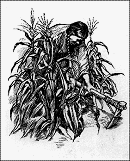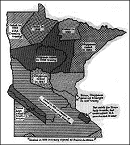| French explorers first reached what is now Minnesota in the seventeenth century, and found groups of Native Americans living in every area of the state. In the south, village farmers planted gardens of maize or corn, but were dependent upon wild plant and animal foods of the prairies and forests for much of their diet. The Dakota or Sioux lived in central and western Minnesota. The Assiniboin, close linguistic relatives of the Dakota, lived in the region from Lake of the Woods west to the Red River Valley; ancestral Cheyenne occupied the lower Red River Valley; and the Algonkin-speaking Cree were in the extreme northeast. Ancestors of today’s Ojibway or Anishinabe peoples (also known as Chippewa) of northern Minnesota had not yet moved into the region from their central Great Lakes homeland. The Native Americans of central and northern Minnesota depended primarily upon wild food resources for sustenance. |
|
|
Hunters and Gatherers

Indian Woman, using a scapula hoe.
Drawing by Frederick N. Wilson
Minnesota Historical Society.

The land cessions by the Indians of Minnesota
(adapted from Poatgieter and Dunn’s Gopher Reader)
|



